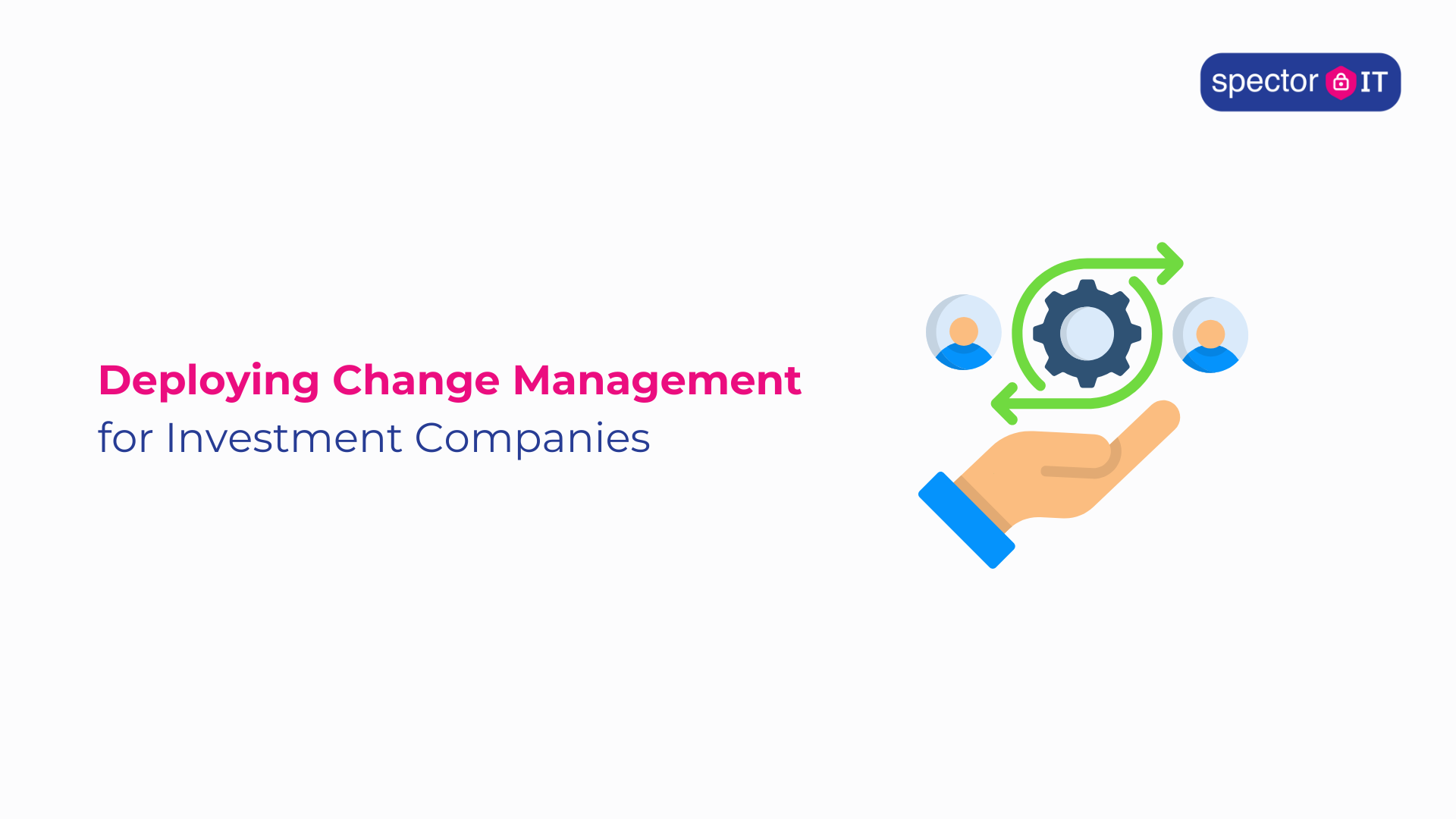
Deploying Change Management for Investment Companies
Investment firms operate in a world where data integrity, compliance, and operational resilience are paramount. That’s why Change Management for investment companies is not just essential—it’s strategic. At Spector IT, we help investment firms manage change with minimal disruption and maximum agility.
Why Change Management for Investment Companies Matters in 2025
-
Data risks are rising: Cyber threats target the financial sector with increasing sophistication—phishing, ransomware, API abuse.
-
Regulation is tightening: Frameworks like DORA, MiFID II, and GDPR demand proactive IT control.
-
Downtime is costly: Even minutes of system downtime can impact trades, client trust, and revenue.
By implementing structured change management, investment firms can update systems and adopt new tools without risking compliance or productivity.
Related read: Change Management for SMEs – A 2025 Playbook
Top Risk Areas for Investment Companies Requiring Change Management
1. Cybersecurity Transformation
Investment IT environments must evolve to handle rising threats. Change management ensures tools like Zero Trust access, conditional controls, endpoint monitoring, and MFA rollouts are implemented securely and inclusively.
2. Regulatory & Compliance Shifts
Rolling out compliance-aware systems—such as enhanced logging, role-based access, and encrypted storage—requires clear governance and training to avoid missteps and ensure audits pass cleanly.
3. System Upgrades & Migration
Investment systems often rely on legacy software or trading platforms. Change management helps plan and sequence migrations so that business continuity is maintained during upgrades or server moves.
4. Vendor Ecosystem Changes
As firms integrate fintech tools or new APIs, change governance ensures those integrations don’t introduce security gaps or compliance violations. Vetting and control is key.
Four Pillars of Effective Change Management for Investment Companies
1. Executive Sponsorship & Governance
Assign a senior lead—either from your IT or business leadership—who champions change. Senior sponsorship ensures goals, milestones, and risk awareness are actively supported. Establish a Change Advisory Board (CAB) with reps from compliance, IT, operations, and risk teams.
2. Structured Change Lifecycle
Every initiative should follow a lifecycle:
-
Request → Assess → Approve → Implement → Validate
Leverage lightweight backlog tools like Trello or Jira to run CAB processes with clarity.
3. Stakeholder Communication & Training
Communicate impacts early and train users at key phases, e.g. new email platforms or access policies. Train via short videos, live sessions, and role-specific emails to boost adoption and limit confusion.
4. Continuous Improvement & Measurement
Use metrics like:
-
Change success rate (percentage completed without rollback)
-
Post-change incident volume
-
User support tickets
Regularly review and refine your process to improve adoption and reduce risk.
For an industry example, Gartner reports firms using formal change practices reduce project failures by up to 33%. Read more here on organisational change management.
Real-World Scenarios Where Change Management Matters
-
Platform Migration: Switching to Microsoft 365 with retention policies, DLP, and Teams rollout.
-
Regulation-Driven Changes: Implementing GDPR or DORA controls—secure storage, audit logs, and reporting automation.
-
Growth and Expansion: Rolling out the same infrastructure to new offices or branch locations without disruption.
These strategic changes need governance, training, and change monitoring to succeed.
Related read: IT Change Management in Finance: Why It’s Critical in 2025
Key Metrics Boards Care About: Measuring Change Success
-
Change Success Rate: > 95% without needing rollback
-
Incident Rate Post-change: ≤ 5% of average ticket volume
-
Time-to-Complete Change: ≤ 72 hours for standard changes
-
User Error or Help-desk Tickets: Decline over quarter
-
Compliance Pass Rate: 100% during audits
These KPIs show that your approach isn’t only about managing risk—it’s about delivering measurable efficiencies.
Read more on
Common Change Management Pitfalls and Fixes
-
Lack of senior sponsorship → projects stall. Fix: Empower a senior sponsor with clear decision roles.
-
Too many manual steps → CAB becomes a bottleneck. Fix: Use digital tools for requests and approvals.
-
Insufficient end-user support → staff fear change. Fix: Provide clear guides and a dedicated support channel during rollout.
-
Ignoring feedback loops → you repeat avoidable mistakes. Fix: Conduct post-change review sessions and refine governance.
Ready to Align Your IT Strategy with Business Growth?
In conclusion, change management for financial services, especially for investment companies is not merely a best practice; it’s a necessity. Successful IT operations require not only staying current with technology but also adapting to change strategically while managing risks and fostering a culture of innovation.
Change management is the compass that guides financial companies through the dynamic IT landscape, helping them thrive and deliver value to their organisations.
For more insights into the dynamic world of IT and technology within the financial sector, contact us today to schedule a no-obligation Discovery Call to discuss how we can assist you in implementing IT change management best practices and ensuring your IT department within your financial company is well-prepared for the future.
Post updated on 24/07/25

